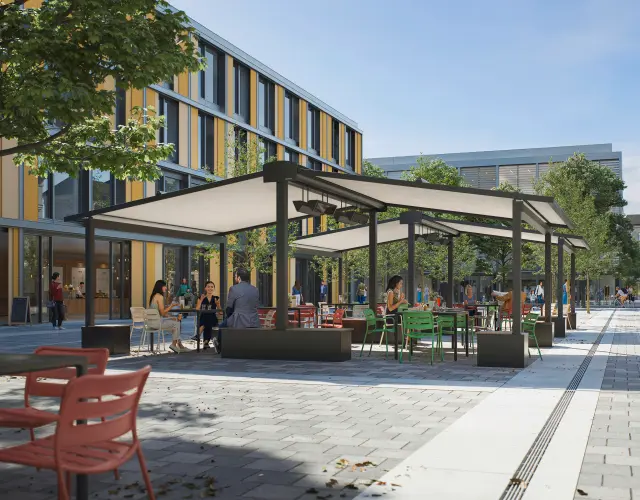
Sun shading exactly where needed Free-standing awning frame with a wide range of applications
One support product, two uses: The flexible, free-standing frame for patio and pergola awnings from Warema offers adaptable shading solutions for the hospitality industry, public spaces, listed facades, or residential homes. The range of applications is as broad as the installation options – it can be equipped on one or both sides and mounted with foundations, on facades, or with weighted boxes.
Free-standing sun shading and weather protection solutions are often required for outdoor hospitality. However, structural conditions or municipal regulations often do not allow for an awning to be securely attached directly to the facade or anchored in the ground for reliable sun protection. In private residential construction, mounting on the facade can also be challenging. This is the case for prefabricated houses in delicate timber construction, as well as older buildings subject to heritage protection regulations or with insufficient structural integrity. Warema's free-standing awning frame meets all these requirements and allows for harmonious integration with facade architecture. Notably, it can be used for pergola, cassette and patio awnings.
The frame can be equipped with an awning on one or two sides and is available with a width of up to 7 metres and a system height of 4 metres. If frames are installed in a row and equipped with awnings on both sides, they can be used to cover large outdoor areas: for example, a frame equipped on two sides with Terrea K60 cassette awnings with a width of 7 metres and projection of 4 metres can provide sun shading for a total of 56 square metres. The awnings can be extended and retracted at the same time using the WMS radio system, regardless of the number of frames. The colour of the powder-coated frame can be freely selected from the Warema colour range to fit in with the overall concept.
Up to four designer radiant heaters can be installed to ensure a pleasant outdoor experience when the temperature drops. Power supply cables can be integrated unobtrusively through the pole and crossbeam, and a power socket can also be integrated into the frame pole.
The frame is installed using concrete bases, or with the aid of weighted boxes that can be positioned flexibly. These boxes have the advantage that the frame can be uninstalled at any time without a trace. This is particularly important in hospitality, for example in pedestrian zones that must be kept empty out of season.
Weighted boxes for the free-standing awning frame have the same design as those for Perea pergola awnings. This allows both products to be freely combined while maintaining a consistent look.
Note on image usage:
The use of the unchanged images is only permitted in the context of mentioning WAREMA by name as the manufacturer of the products shown and exclusively for editorial reporting on WAREMA products, not for advertising purposes. Please use "Copyright WAREMA" as the correct acknowledgment of the source. By using the image you agree to the terms and conditions. Please send a digital specimen copy.
Downloads
The free-standing awning frame from Warema can be equipped on one or two sides. The frame is installed using concrete bases, or with the aid of weighted boxes that can be positioned flexibly. Up to four designer radiant heaters can be installed to ensure a pleasant outdoor experience when the temperature drops.
A double-sided equipped awning frame, for example with Terrea K60 cassette awnings with a width of 7 meters and a projection of 4 meters, provides sun protection for an area of 56 square meters.
Especially large open spaces can be reliably shaded with multiple free-standing awning frames installed in a row, whether with pergola or terrace awnings.
The colour of the powder-coated frame can be freely selected from the Warema colour range to fit in with the overall concept.
Free-standing sun shading and weather protection solutions like the awning frame are often required for outdoor hospitality.
In private residential construction, the free-standing awning frame from Warema is also used when mounting on the facade is challenging. This applies to prefabricated houses with delicate timber construction as well as older buildings that are subject to heritage protection regulations or have insufficient structural integrity.
Share this page:
Your direct contact to us







